In this article, we will look at a topic that has been increasing in focus lately - Google Core Algorithm Updates.
We will cover what happens during algorithm updates from Google and other search engines, how to correctly analyse an update once the rollout is complete, how and when to take action, and we'll give you a few examples of core update recovery.
We also have some thoughts on reading and interpreting Google's official documentation.
So let's get into it.

Why the Sudden Increase in Updates?
Before we jump into the meat of the article, though, we need to talk about why there has been an increase in algorithm updates recently. In fact, over the past 12 months, we have seen no less than nine confirmed algorithm updates from Google alone!
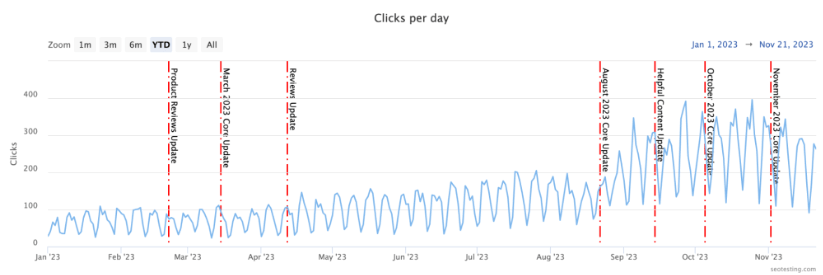
We must talk about the increase in updates by talking about ChatGPT and other AI-based tools that can generate content. You may have noticed that we generated the header image for this article using ChatGPT.
The increase in people, whether website owners, marketing professionals, general content creators, or anyone using these AI-based tools to generate content, means Google must pivot to keep their SERPs relevant and up-to-date consistently.
While AI is great at generating certain content or can help formulate ideas, it isn't necessarily the greatest at generating new, fresh content. Because of this, Google needs to find new ways to 'sniff out' this AI content and ensure it is relevant and will help the user.
There is also a straightforward reason why constant updates are needed. Around 252,000 new websites are created daily, many of which will start posting content regularly. Google's job is to bring the best results to the user, regardless of their search. If any of these created websites start producing better content, Google will want to help these get in front of users.
What Happens During Google Algorithm Updates
Whenever Google announces a new core update, whether a broad core algorithm update, a Helpful Content Update, a spam update, or a product reviews update, one of three things will happen to your website.
Your website may see a boost in traffic following the update. It could also see a decline in traffic following an update. Or your website may see no meaningful change at all following the update.
Positive Impact
You may find that, following a Google update, your site sees an increase in traffic. This happened to the SEOTesting website following the Google Core Update in August of 2023, which you can see here:
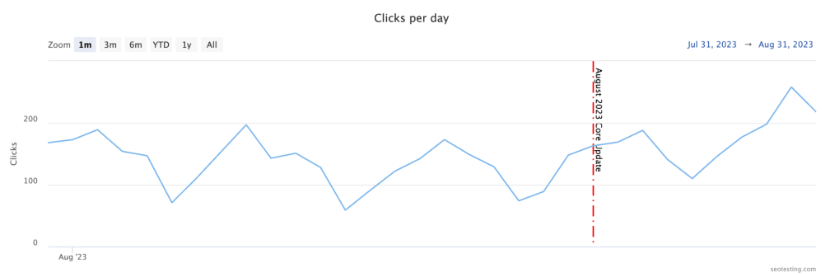
You can see the near-immediate impact of this core update, resulting in more clicks coming to our website. Using our 'Compare Pages' report, we can see which of our pages saw an increase in traffic following the update and what increase each page saw:
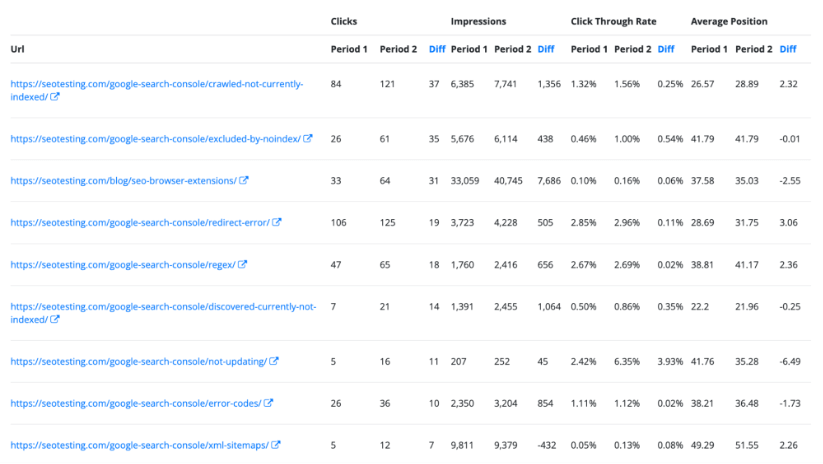
This is a classic example of what a site can see following an increase from any search engine update. Certain pages may still decline in traffic or stay the same, whilst certain pages will see a noticeable increase in traffic following the update!
Negative Impact
On the flip side, you will also see occasions where websites notice a noticeable traffic decrease following a search engine update. The following screenshot is a classic example:
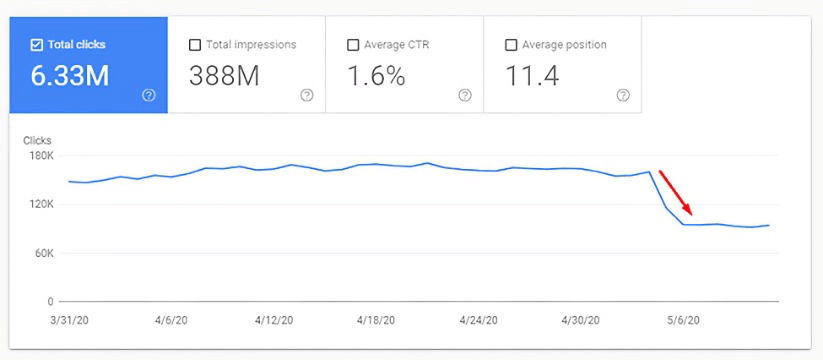
Again, there are different reasons for this, which we will go into a little further in the article, but this could be down to certain essential pages seeing a decrease or your site as a whole seeing a decrease in traffic.
No Meaningful Change
Of course, there is another option following search algorithm updates, and that is not seeing any meaningful change in your site traffic. You can see this in the screenshot showing SEOTesting's site traffic below:

Significantly, earlier on in the year, you can see that we went through three search algorithm updates without seeing any significant changes in our website traffic.
- Product Reviews Update
- March 2023 Core Update
- Reviews Update
We continued steadily increasing traffic (after publishing lots of great content, building our brand, and building highly authoritative and relevant links) until the August 2023 Core Update, where we saw a significant increase in traffic almost immediately following the update.
Analysing the Update
In this next section, we explore what you can do to analyse your website following any search engine algorithm update. What to do, what not to do, and what tools you can use to analyse the update.
Whole Site Impact?
In rare cases, you may see that most of your site has been impacted following a search engine update. The following screenshot shows a classic example:
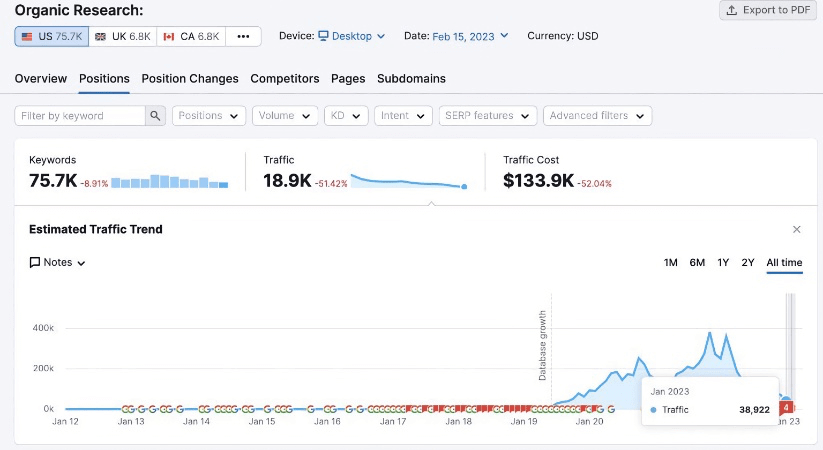
You can see from the screenshot above a search engine algorithm update has negatively impacted the vast majority of this website! The site has gone from peak traffic of just under 400,000 to a site traffic level of just under 39,000.
The majority of this website has been impacted. It's not just one or two essential pages that have declined in traffic following the update.
The website owner can do a deeper dive, jumping into traffic page by page to see the impact of each page. But given the likely scenario is this website has seen a 'whole site' impact, then this step isn't necessarily vital, although it is still important!
More Realistic: Finding the Impacted Pages
Given that the more realistic finding during traffic loss from a search engine update is that only certain pages are declining in traffic, you need to find out which pages are slipping in traffic and to what extent they are reducing traffic.
Is it one or two key pages that have declined by a huge percentage? This may be the case, especially for smaller websites that still need a lot of content or a high traffic level to start with. If one page gets 50% of your traffic, and this page drops during a search update, your site will see a huge traffic drop.
Or is it the case that many of your pages are seeing smaller drops? If you find this, it may be that Google is evaluating your site on a deeper level and seeing it as less helpful than competitors once they have updated their search algorithms. If this is the case, you will have to do different things to recover than if your website has seen some essential pages drop in traffic.
You can use the Content Decay report on SEOTesting to find pages losing traffic in the last 12 months, saving you some time to find pages affected.
Taking Appropriate Action
In this next section of the article, we'll discuss what to do when you have seen a drop in website traffic following any search algorithm update.
Listing Impacted Pages
We talked above about finding pages that have dropped in traffic following a search algorithm update. Everyone has different ways to do this.
If it's a small website, using GA4 will offer enough to dive in and list all the pages that have declined in traffic following an update. If the site is larger, then it might be a case that their SEO/marketing agency may need to do this analysis for them as they have access to the tools required to do a deeper analysis.
Or, in the majority of cases, you can use SEOTesting's Compare Pages report, which allows you to jump straight into a confirmed algorithm update and see exactly which pages have declined in traffic and how much their traffic has declined:
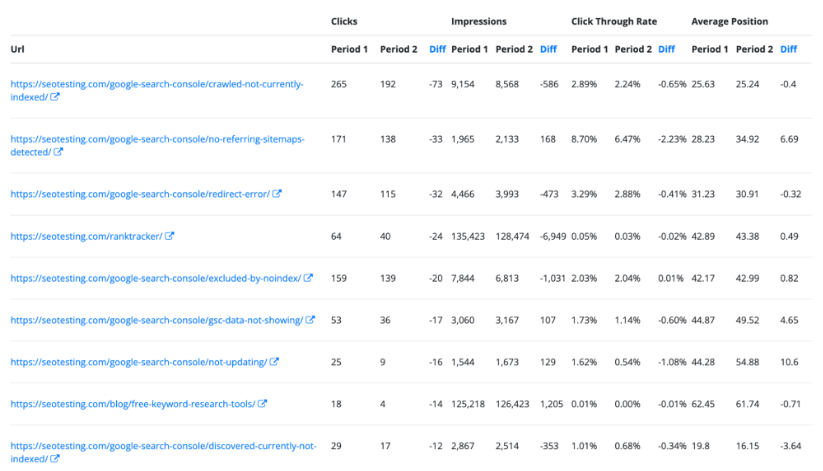
The screenshot above shows SEOTesting's slight decline in traffic following Google's most recent search algorithm update. In this case, it's the November 2023 Core Update. We can see that our article delving into the Crawled - Currently Not Indexed status has declined significantly in traffic compared to other pages that have also dropped.
Other pages have declined, including the page advertising our rank tracking tool, our article on free keyword research tools, and our article explaining what to do if GSC is not updating.
Conducting Competitor Analysis
Conducting a competitor analysis after seeing a drop in website traffic due to a search algorithm update is essential to seeing any traffic recovery. Begin by identifying your direct competitors that are now ranking well for your target keywords.
Use SEO tools like Ahrefs or Semrush to analyse their websites, focusing on changes in content quality, keyword usage, backlink profiles, and website structure. Observing competitors' performance, especially those who have improved their rankings (and probably their traffic, too) after an update, can provide insights into the new algorithm's requirements and successful strategies for adaptation.
The next step is to evaluate the content and SEO strategies of your now top-performing competitors. Look for patterns in their content, like the length and depth of articles and their use of media like images and video, which might contribute to their new success. Also, review their on-page SEO tactics. What title tags are they using? What meta descriptions are they using? How are they using headers within their content?
This comparison can highlight necessary adjustments for your website to understand effective practices rather than copy them.
Making Improvements
The final step is to implement changes on your website based on your analysis.
This might involve updating content, improving various facets of your on-page SEO, enhancing your site structure, or even going out into the world of backlink acquisition and obtaining new, relevant, and authoritative backlinks.
Monitor your website's performance closely after these changes, using analytics tools like GA4, GSC, or SEOTesting to monitor traffic, bounce rate, and keyword rankings.
Be prepared that ongoing adjustments are needed, as search algorithm updates are constantly coming and will not slow down. Stay informed about SEO trends and best practices is crucial for maintaining and improving your website's search performance.
Competitor analysis is ongoing; regularly revisiting and updating your strategies is vital to staying competitive.
Reading Documentation / Communication from Google
If you want more context about Google Core Updates and other Google search updates, a wealth of information is now available.
For starters, Google's Search Status Dashboard gives you all the information you need to know about confirmed Google search updates of the past and will also tell you about ongoing updates so you can keep track of when they are complete or whether they are still rolling.
You can see information about past and current Google updates here: https://status.search.google.com/products/rGHU1u87FJnkP6W2GwMi/history
Google also has a page of extensive information about the reason they perform broad core algorithm updates here: https://developers.google.com/search/updates/core-updates
Examples of Recovery
Luckily, recovery from drops following Google algorithm updates is entirely possible! This is an excellent example from Search Logistics:
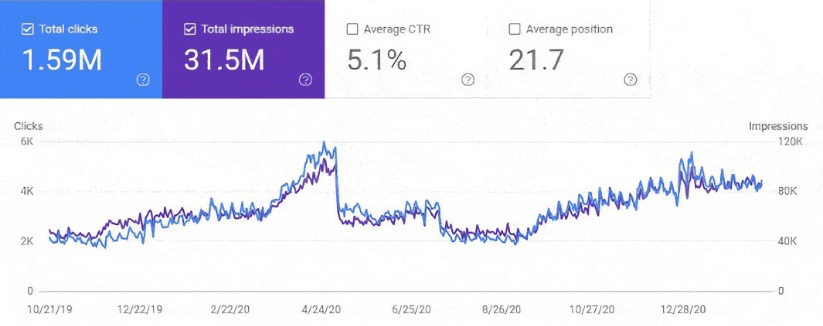
You can see the drop in April 2020 and the slow rise afterwards. The site is now back up to nearly where they were when the site dropped following the update.
Here's another example from GSQi:
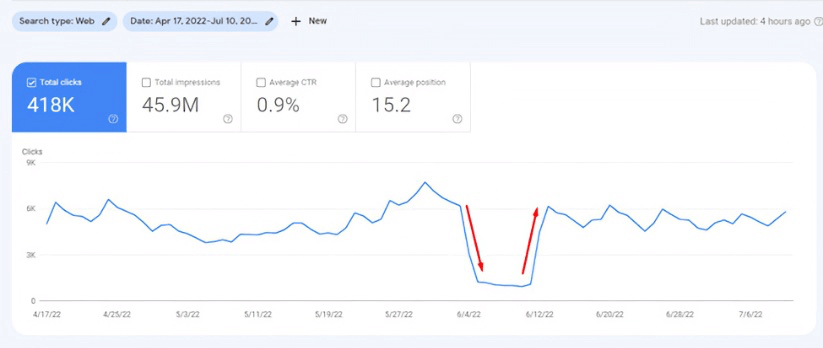
You may notice that these recoveries look very different. That's down to the fact that there are different types of recoveries.
Some recoveries are quick and take you back to near-100%, if not 100%, of the traffic you had before the algorithm update. If this is the case, it's most likely down to another search engine update that has been completed, where they have realised (and fixed) an error that was made.
Other recoveries take longer, like our first example! If this is the case, Google algorithms have not made a 'mistake' and have not fixed this following another update, and manual work needed to be done to 'reverse' the drop from the update. This can come in content optimisations, new content publishing, the acquisition of new backlinks and more!
In conclusion, adapting to Google's frequent algorithm updates is a dynamic and ongoing process. This article has guided you through understanding these updates, analysing their impact on your site, and taking appropriate actions, including competitor analysis and website improvements. Regularly monitoring changes and being proactive with SEO strategies is crucial for recovery and maintaining your site's visibility. By staying informed and adapting to the evolving digital landscape, your website can effectively navigate and benefit from these changes.
Want to make better use of your Google Search Console data? Want to better analyse traffic changes following Google Core Updates? Want to implement SEO testing into your routine? Then give SEOTesting a try! Sign up today for a 14-day free trial to use for your website/s.

